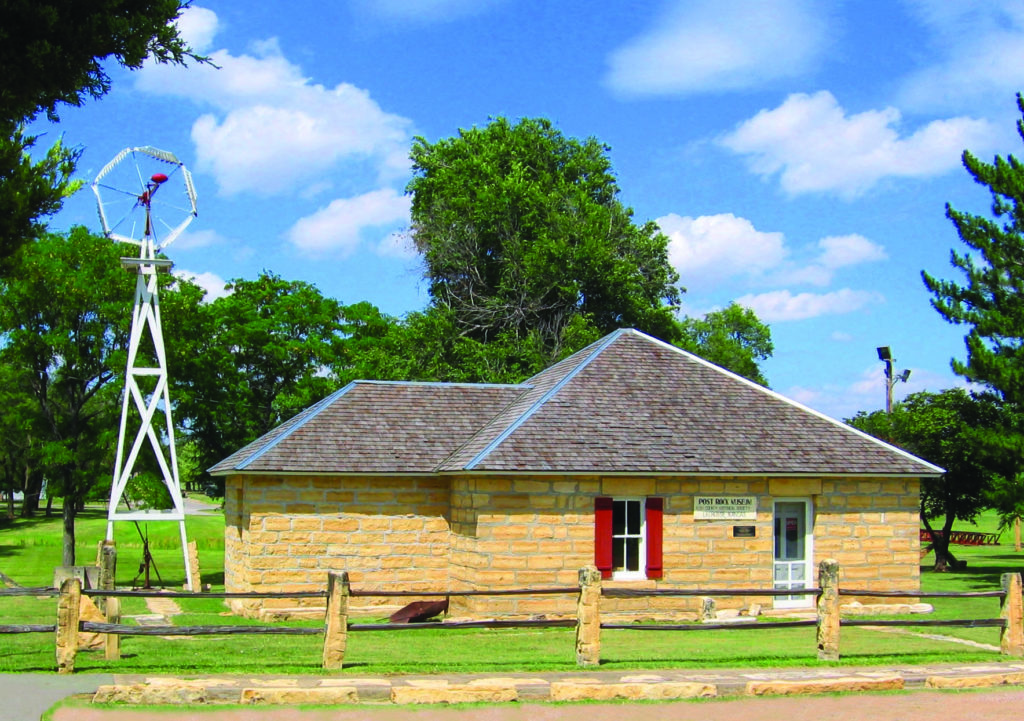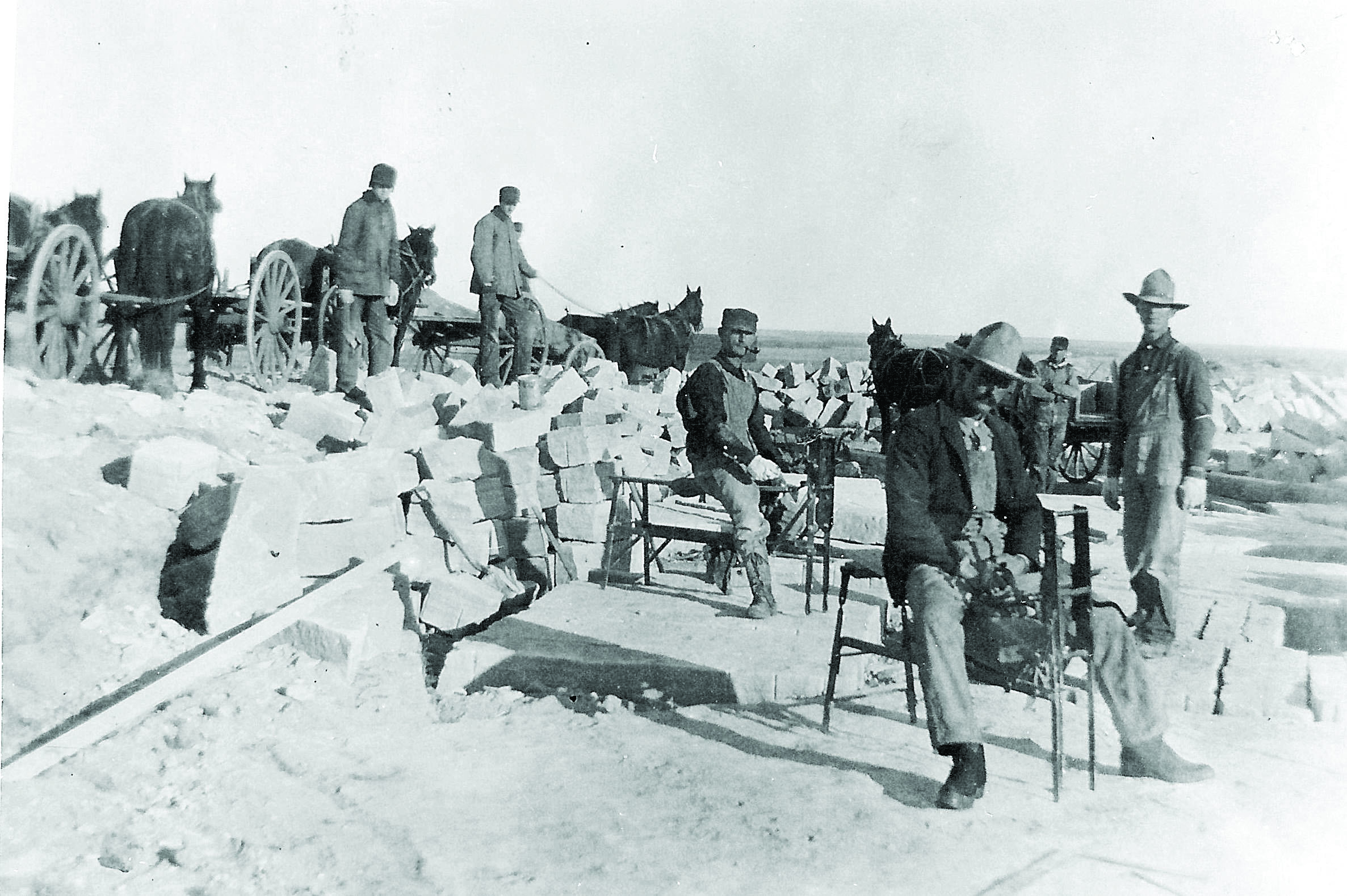
[dropcap]W[/dropcap]hen Congress opened up free land (provided one was willing to make improvements and stay put for five years) on the Great Plains with passage of the 1862 Homestead Act, settlers began to pour into west-central Kansas. But those who chose to make their living as farmers encountered a problem. Cattle ranchers of the era were accustomed to allowing livestock access to what had been open range, a practice that left homesteaders constantly struggling to protect their crops from ruin. The obvious remedy of fencing was not practical on the Kansas plains, as there simply wasn’t a readily available supply of timber for fence posts.
Yet a viable resource lay dormant mere feet beneath the tilled earth, one present for millions of years. In fact, settlers had already employed it in the construction of their homes and other buildings. Known as Greenhorn limestone, the yellow-tan rock proved the solution to the fencing dilemma. No one is certain who first thought to craft it into posts, but post-rock fences began popping up in the early 1870s, slowly sectioning off the open range into cropland.
As a building material, Greenhorn limestone offers several distinct benefits. First, it lies close to the surface—only a few feet belowground. It is also in abundant supply, sprawling across some 200 square miles from Salina west to Hays and the Nebraska border south to Dodge City. Free for the taking, the shale is of a uniform thickness, does not rot and is immune to prairie fires. Furthermore, post-rock is soft and workable when extracted, then hardens when exposed to air. That softness allowed settlers to chisel grooves and notches into the stone to hold the wire they strung between posts.
For a time cattle continued to pose a problem, as they rubbed against the smooth wire in use at the time, loosening posts and breaching fence lines. By the 1880s, however, farmers had turned increasingly to newfangled barbed wire, which when strung from stone posts proved an effective deterrent. At its greatest extent post-rock fencing crisscrossed an estimated 40,000 miles of the Plains.
By the 1920s the time and effort required to cut and transport the stone posts was no longer cost-effective. Replacing them were steel fence posts, which were reasonably priced, readily transported and relatively easy to install.
Brad Penka, a member of the Rush County Historical Society in central Kansas, estimates that fewer than 10 percent of the original stone fence lines remain. “Wood or metal posts are much lighter and easier to handle,” he says. “Farmers also now have equipment that can push a wood or steel post into the ground, rather than digging the hole.”
Kansans regard the surviving post stone fences as cultural artifacts, representing both the land and the hardy people who settled it. At the westbound I-70 rest stop north of Ellsworth, at milepost 224 in the midst of “Post Rock Country,” a historical marker perched atop post-rock slabs relates the story of the unique fencing material. A short drive west, the 18-mile stretch of Kansas Highway 232 from Wilson, just south of the interstate, north to Lucas is lined with stone fence lines and buildings and has been designated as the Post Rock Scenic Byway.
La Crosse, the Rush County seat, is home to the Post Rock Museum, operated by the historical society. Housed in an 1883 stone house that was dismantled and moved to the site, it exhibits the tools used to cut post-rock alongside historic photos of the farming region. “Most people are surprised to learn about the primitive and difficult methods used to quarry the posts and build the fences,” Penka says. The museum opened in 1964 in part to answer the many questions posed by passersby regarding the stone posts. A favorite story tells of one baffled individual who confided to a local, “This is the first place I’ve ever been that has its cemeteries beside the highways.”
• Greenhorn limestone formed tens of millions of years ago as the skeletal remains of coral and other organisms settled to the floor of interior seas then covering Kansas. Look for fossils and petrified wood on the surface of post-rock.
• Each post weighs between 250 and 450 pounds and is 8 to 12 inches thick and 5 to 6 feet long.
• Settlers hauled cut posts with teams of horses pulling a sled or wagon.
• Post holes were a minimum of 18 inches deep and set 15 to 30 feet apart.
• A 160-acre farm required some 360 posts and 40,000 feet of wire.
And How-To:
With slight variations, the “plug and feather” technique used
to create stone fence posts is one stonemasons have employed since the days of ancient Egypt. The method, described below,
is also known as “plugs and wedges,” “feather and wedges,” “wedges and shims,” “pins and feathers” and “feather and tare.”
1. Drill a row of holes into the rock some 6 to 8 inches apart.
2. Drop into each hole two half-round metal shims (aka
“feathers”), each bent at the top to keep them from slipping
into the hole.
3. Drop a wedge (aka “plug”) between each pair of shims.
4 Pound the wedges in succession with a hammer until they
emit the same telltale tone.
5. The next hammer strike should split the stone along the row.
6. Repeat until you’ve crafted a four-sided post.





